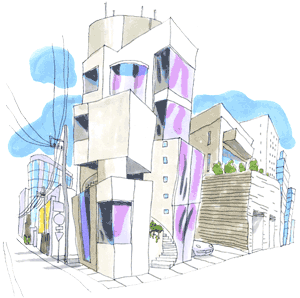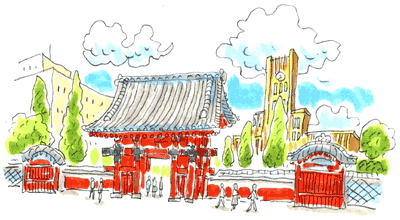
So you’ve just arrived in Japan. You’re going to work, study, teach, go on a homestay, or become the spouse of a Japanese. But how will you become familiar with your new surroundings, so that you can thrive in your new home? This course focuses on the first—and most crucial—part of the acclimation process for newcomers: your entry. How can you move smoothly off of your entry point and begin to navigate effectively in your new environment?
This is the third version of At Home in Japan: What No One Tells You, and we are now expanding the site to include all the characters above. During the past six years over 500,000 learners from 84 countries have learned from this site. From them we received an avalanche of feedback that was overwhelmingly positive. Most felt they had gained practical knowledge that had actually helped them to function appropriately in Japan. So we’re keeping the same focus in this version: rather than “textbook learning”, this course presents the kind of learning you need for being there—whether you are learning to get along with co-workers, make friends, or perform your duties in a student dorm. Even if you are learning about Japan from a distance, and don’t have any plans to go there, this course allows you to understand Japanese culture as if you were there. The vantage point of “being there” utilizes anthropological approaches to culture (and language) which focus on “doing”, or performance.
Learning how to transition smoothly beyond your entry point is a crucial challenge for newcomers anywhere, not only Japan. But while you might think this transition is largely automatic, and requires little effort on your part—the truth is just the opposite. If you don’t make an effort in the beginning you may end up “getting stuck” at your entry point. Many newcomers to Japan find their entry situations to be both appealing and comfortable, and assume that they are experiencing “Japanese society”, but what they are actually experiencing is interactions directed toward them as newcomers. Others are dissatisfied with their entry point situations, but give up on ever being able to improve a situation they find disappointing. The first group feels their stay is unblemished by any problems, while the second group often becomes dissatisfied—and sometimes bitter—about situations and relationships they find very unsatisfactory.
From our perspective, both of these groups have gotten “stuck” at the entry point; they never really began the process of acclimation to Japanese society. This means they have missed a challenging and sometimes baffling process that nonetheless can be deeply rewarding, and produce lasting relationships for both sides. This is true even if the newcomer takes only small steps beyond the entry point.
Crucial in the failures of both groups is a critical minefield in the cultural communication process: the things that no one thinks to tell a newcomer. These are not mentioned, precisely because it is assumed that everyone must already know them. Yet ironically, these are the very things one most needs to know in order to adjust successfully, and they may not be obvious to the newcomer at all. While this minefield exists for all cultures, in Japan it is compounded by cultural expectations of not speaking directly; because others are expected to intuit what one is not saying. It goes without saying that this is difficult for newcomers to manage.
Our goal in this course is to present a program of practical learning that will allow you to grasp what you need to know in order to move beyond your entry point. Much of this learning involves things that no one tells you—but assumes that you will already know. This course focuses on you, because the crucial aspect of moving beyond your entry point is that the experience centers on you. Through a process of trial and error you must learn the appropriate things to say and do to get beyond being a perpetual newcomer.
The course consists of a series of interactive modules which replicate the trial-and-error learning process that you face in “being there”. The seven characters who entered the scene above are important to your learning. You are encouraged to identify with the character that most closely approximates your own situation (and you are also encouraged to “try on” the other characters as well). This will allow you to participate as a fly on the wall in their learning situations—and you get to escape the social repercussions your errors would produce in real life.

The course consists of four parts:
Part 1 (Modules 1-3) explains how unspoken meaning works in intercultural communication by introducing you to Peter Hauser, a homestay guest, and the Sasakis, his host family. The homestay introduces the core idea of the course: How can Peter become aware of what no one thinks to tell him, but which everyone assumes he already knows, before he unknowingly violates their expectations? Part 1 then shows how a similar question may be lurking behind all the other characters in their entry point situations as well.
Part 2 (Modules 4-6) begins to fill in what you need to know in order to understand “what no one tells you”. It explains behind-the-scenes aspects of Japanese society that are the backdrop to what is made visible in ordinary communication situations, and introduces a set of distinctions between inside and outside, that are communicated across a wide spectrum of social life.
Part 3 (Modules 7-10) lets you follow fourteen students through the trial-and-error learning process of actual homestays, as presented through their diary notebooks. Part 3 is designed to help you learn how the unspoken meaning in Part 1 and the distinctions between inside/outside, and what is kept “behind the scenes” and made visible in Part 2, work in real-life situations.
Part 4 (Modules 11-14) shows you how the trial-and-error learning process of all the newcomers in their various situations is closely related to that of the homestay students in Part 3. A series of flash programs helps the learner understand how this learning process gradually “moves” the newcomers off their entry point and along a pathway toward cultural adulthood, which coincides with entering ‘uchi’. The learner is then assisted in using the learning process of the newcomers in navigating his or her own entry situation in Japan.

A word of caution:
- Each section of this course builds on the information presented before it. The last section won’t make sense unless you have already grasped the “basics” presented in Parts 1 and 2. It is very important that you move through this course in sequence, although you can retrace your steps back through the course as much as you like.
- This course is too large to finish in a single sitting. While we estimate that Part 1 takes approximately an hour, Parts 2—4 take longer, because you are encouraged to relate the characters and their cases to your own situation. There are many threads you can draw between the pages and cases of the course, and you are the meaning builder in this site. You can (and should) spend time on this course so please plan accordingly.
















